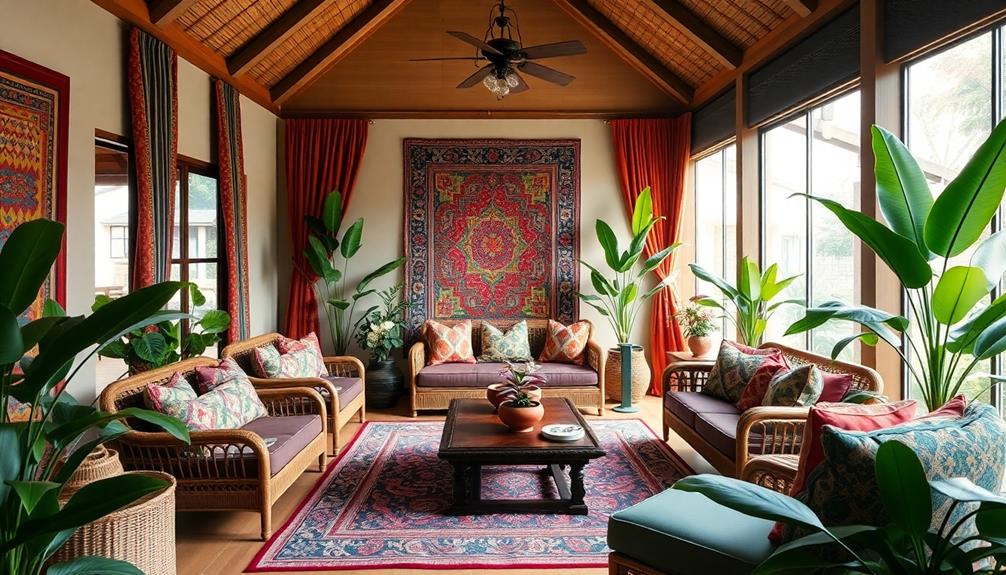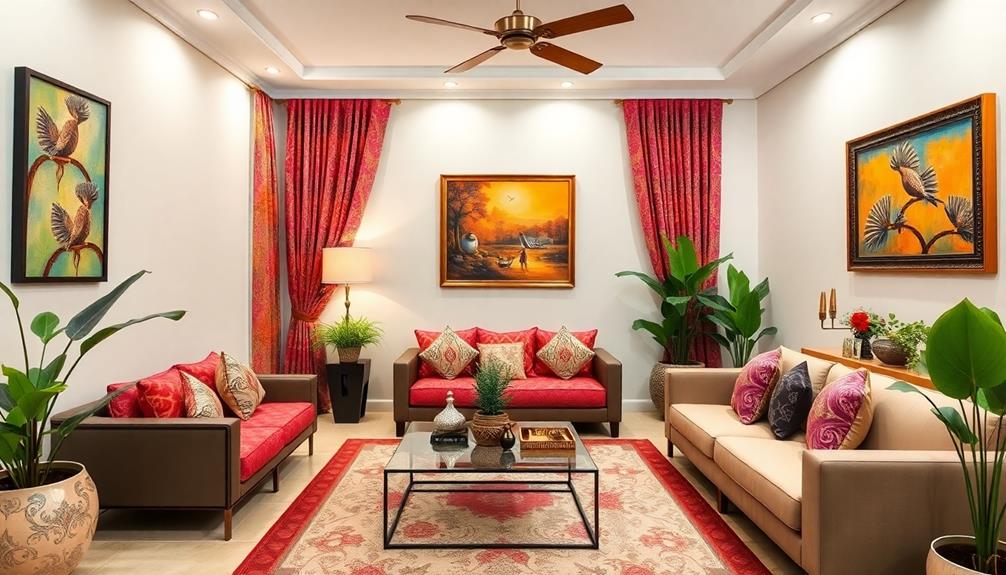To master mixing Indonesian textiles in your interior, start with a cohesive color palette inspired by vibrant fabrics like Batik, Ikat, and Songket. Use contrasting elements to create visual interest—pair intricate patterns with solid colors. Incorporate various textures for depth by layering Batik throws with Ikat cushions. Establish focal points, like a statement Batik wall hanging, to enhance your design's impact. Keep the number of patterns limited to avoid clutter and maintain harmony. By thoughtfully blending these elements, you can celebrate cultural heritage while showcasing your personal style. Stick around to explore more practical tips for a dynamic interior.
Key Takeaways
- Establish a cohesive color palette inspired by the vibrant hues found in Indonesian textiles to create visual harmony in your interior.
- Combine contrasting elements, like intricate batik patterns with solid colors, to add visual interest and depth to your space.
- Incorporate a variety of textures by blending smooth batik, rough ikat, and rich songket for a dynamic tactile experience.
- Limit the use of patterns to 2-3 to maintain clarity; balance bold prints with solid colors for a harmonious look.
- Use Indonesian textiles as focal points and layering techniques to define spaces and create an inviting atmosphere in your home.
Principles of Mixing Design Styles
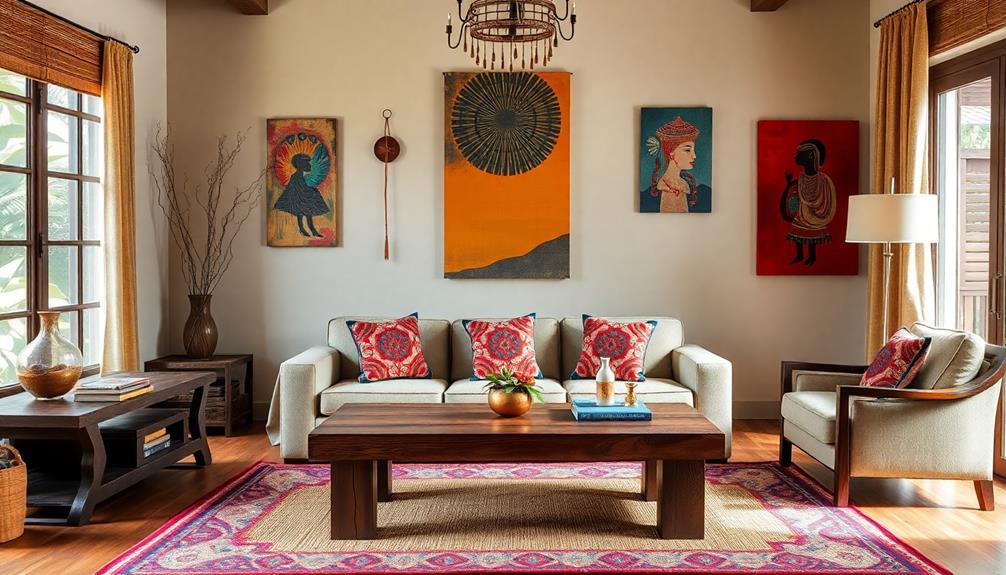
Mixing design styles can transform your space into a vibrant reflection of your personality. To start, establish a cohesive color palette that incorporates shades from Indonesian textiles, like the bold colors of batik or the earthy tones of woven fabrics. This harmony sets the foundation for your design.
Incorporating Indonesian decorative pillows can also enhance comfort while adding cultural richness to your space.
Next, balance contrasting elements—think the intricate patterns of batik paired with the simplicity of solid colors. This creates visual interest without overwhelming your space. You'll want to incorporate a variety of textures, too. The smoothness of silk batik can beautifully contrast with the roughness of hand-woven ikat, adding depth and tactile appeal.
Layering is another key principle. Combine different types of Indonesian textiles, such as using batik cushions on an ikat sofa, to achieve that curated, eclectic look.
Finally, don't forget to establish focal points. Position standout pieces like a large batik wall hanging or a statement ikat rug to anchor your design and draw attention.
Understanding Batik Fabric

Batik fabric is a stunning example of Indonesian artistry that can elevate your interior design. This traditional textile is created through a wax-resist dyeing process where artisans apply hot wax to fabric before dyeing it in vibrant colors. The term "batik" comes from the Javanese word "bathikan," meaning to draw or mark, reflecting the intricate craftsmanship involved.
Not only does batik add a unique aesthetic to your space, but it also encourages appreciation for traditional craftsmanship, making it an ideal choice for cultural decor enthusiasts.
Originating in Indonesia, particularly Java, batik showcases distinct regional styles such as Batik Tulis (hand-drawn), Batik Cap (stamped), and Batik Lukis (painted). Each style has its own unique aesthetic and texture, allowing you to choose pieces that resonate with your design vision.
Batik motifs often convey cultural significance, with specific patterns representing social status or virtues. For instance, the parang pattern is traditionally reserved for royalty, adding an element of exclusivity to your décor.
With UNESCO recognizing Batik Cap as an important cultural heritage, batik's historical and artistic value is undeniable. Incorporating batik into your interior not only enhances the visual appeal but also connects your space to a rich cultural tradition, making it a meaningful addition to your home.
Cultural Significance of Batik

Cultural Significance of Batik
Incorporating batik into your decor not only enhances the aesthetic but also connects you to its rich cultural significance. Batik motifs, steeped in Indonesian culture, often signify social status, nature, virtues, and history. For example, the parang motif is traditionally reserved for royalty, highlighting its importance in the social hierarchy.
Additionally, these intricate designs are similar in their storytelling role to Indonesian decor masks, showcasing local myths and folklore. Batik garments are more than just beautiful fabrics; they're considered family heirlooms that represent cultural heritage. You'll find them worn in various cultural contexts, from theater performances to significant celebrations, illustrating their integral role in communal life.
The historical significance of batik extends beyond Indonesia, with ancient wax-resist dyeing practices found in places like China, Japan, and Africa, showcasing its global influence. Institutions like the Batik Guild in London and the Pekalongan Batik Museum emphasize the ongoing relevance of this art form.
Importantly, current Indonesian presidents frequently highlight batik at public events, reinforcing its cultural significance and role in national identity. By choosing batik for your interior design, you're not just adding a decorative element; you're embracing a rich narrative that spans centuries and cultures.
Color and Texture in Interiors
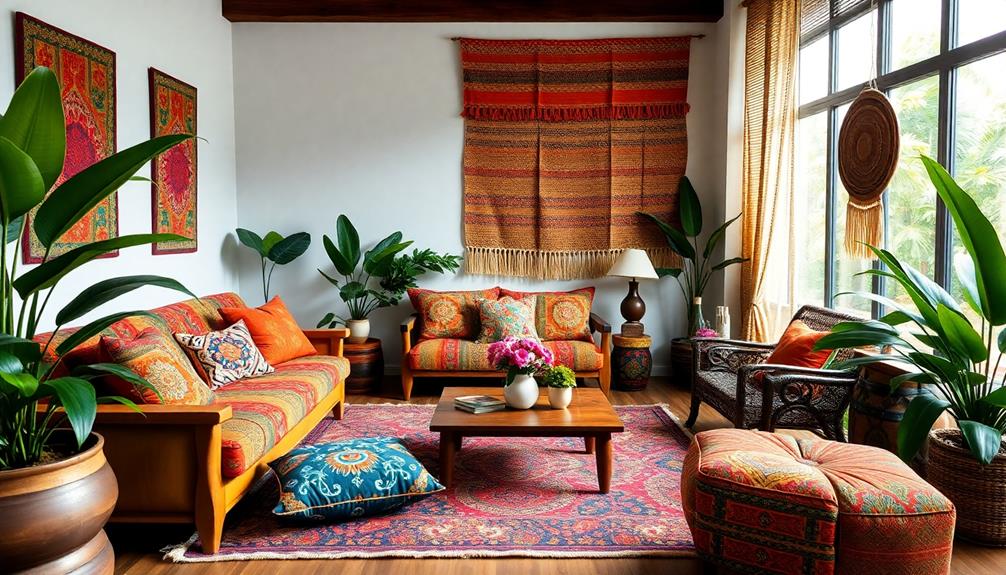
When you mix Indonesian textiles in your interior, pay attention to color harmony to create a cohesive look.
By blending the smoothness of Batik with the rich textures of Songket, you can enhance the sensory experience in your space.
Incorporating traditional textiles can also reflect the essence of traditional Indonesian style home decor while adding an authentic cultural touch.
Consider how different colors and textures can reflect your personal style while adding depth and warmth to your home.
Color Harmony Techniques
To create a harmonious interior that showcases the beauty of Indonesian textiles, it's essential to focus on a cohesive color palette. Start by selecting vibrant hues often found in these textiles, such as rich reds, deep blues, and earthy tones. This will help establish a unified look in your space.
Pay attention to color psychology as well; warm colors like yellows and oranges can evoke a welcoming atmosphere, while cooler tones offer calmness and serenity. Additionally, consider incorporating natural materials in your design to enhance the overall aesthetic and connect with the essence of Balinese decor.
Incorporate different textures to add depth without compromising your color palette. For instance, mix the smooth finish of batik with the rougher texture of woven ikat to create a tactile appeal. Use accent pieces, such as bold batik-patterned pillows or throws, against solid-colored furniture. This creates visual interest while maintaining balance in color and texture.
Don't forget to use neutrals as the foundation of your color scheme. They allow the intricate patterns and colors of Indonesian textiles to shine while providing a cohesive backdrop for your overall design.
Textural Richness Exploration
Textural richness transforms interiors into enchanting spaces where culture and comfort coexist. Incorporating Indonesian textiles like Batik and Songket enhances your decor with vibrant colors and intricate patterns. By mixing textures, you create depth and tactile interest. For instance, combine the smooth surfaces of silk Batik with the rough feel of handwoven Ikat. Accessories like cushions, throws, and rugs made from various Indonesian fabrics layer textures effectively, giving you a curated look that remains harmonious.
Consider the psychological impact of colors in your textiles. Warm hues invite coziness, while cooler tones promote tranquility. A cohesive color palette that reflects shades from your textiles guarantees everything complements beautifully.
Here's a quick visual representation to inspire your exploration of textural richness:
| Texture Type | Material Example | Effect |
|---|---|---|
| Smooth | Silk Batik | Adds elegance and shine |
| Rough | Handwoven Ikat | Introduces rustic charm |
| Soft | Cotton Cushions | Enhances comfort |
| Luxurious | Songket | Infuses opulence |
| Layered | Mixed Fabrics | Creates visual interest |
Layering Techniques for Textiles
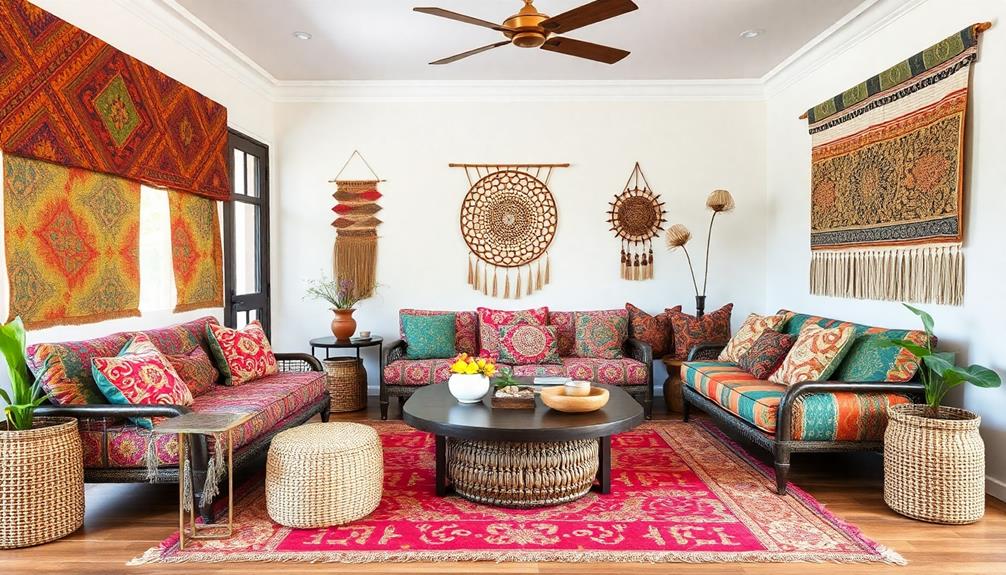
When you layer Indonesian textiles in your space, think about combining various textures and patterns for a dynamic look.
Incorporating elements like traditional artistry through vibrant Indonesian decor masks can enhance the visual appeal.
Integrating cultural elements like Batik and Ikat can add depth, but you need to maintain balance to keep the design open and inviting.
Combining Textures and Patterns
Layering textiles in your interior can transform a space into a vibrant tapestry of culture and comfort. When mixing patterns, consider combining various Indonesian textiles like Batik and Ikat. These textiles tell a rich visual story, reflecting the cultural heritage of Indonesia.
Using a larger Batik-patterned throw as a base can anchor your design, while smaller Ikat-patterned cushions add contrast and interest. To create a harmonious environment that feels connected to the outdoors, you might also integrate eco-friendly design elements, enhancing the overall aesthetic and sustainability of your space Tropical Contemporary House.
To enhance the tactile appeal of your space, mix textures by pairing the smoothness of Batik with the rougher feel of Ikat. This interplay of textures not only creates depth but also invites touch, making your space feel more inviting.
Limit your selection to 2-3 different patterns to maintain visual clarity and cohesion, ensuring your design remains inviting rather than chaotic.
Additionally, consider incorporating cultural elements, like traditional Songket, as wall art or table runners, to further enrich your interior. By thoughtfully layering these textiles, you'll create an environment that reflects both personal style and cultural appreciation, making your space truly unique.
Embrace the beauty of mixing patterns to elevate your interior design game!
Cultural Elements Integration
Integrating cultural elements into your interior design adds a rich narrative that celebrates heritage while enhancing your space. By layering traditional Indonesian textiles like Batik and Ikat with contemporary fabrics, you create a dynamic contrast that reflects both heritage and modern aesthetics.
Consider enhancing your designs with inspiration from luxury tropical design aesthetics that blend natural elements seamlessly. Here's how to effectively achieve cultural elements integration:
- Use Batik Tulis for intricate detailing alongside Batik Cap for uniform patterns, offering visual diversity while maintaining authenticity.
- Incorporate rough Ikat cushions against soft Batik throws to enhance texture and depth in your design.
- Position textiles as focal points—consider a large Batik wall hanging or an Ikat-upholstered chair to draw attention to cultural elements.
- Mix various cultural motifs thoughtfully, ensuring colors and patterns complement each other to avoid chaos and celebrate Indonesia's textile heritage.
Balance and Open Space
Achieving balance and open space in your interior design is essential for showcasing the beauty of Indonesian textiles. Start by layering various fabric types, like Batik, Ikat, and Songket, to create visual richness. Use larger textiles, such as wall hangings or throws, as dominant pieces, while smaller accessories like cushions or table runners serve to accentuate.
Consider the scale of your room when layering. Larger patterns work best in spacious areas, while intricate designs complement intimate settings. This guarantees balance without overwhelming the space. Mixing smooth and textured fabrics, such as a soft Batik cushion paired with a rough-hewn Ikat throw, enhances tactile appeal and creates a dynamic layering effect.
Lastly, establish open space between layers of textiles to prevent visual clutter, allowing each piece to stand out. Here's a quick guide to help you visualize the balance:
| Textile Type | Suggested Size | Room Type |
|---|---|---|
| Wall Hanging | Large | Open Spaces |
| Throw | Medium | Living Rooms |
| Cushion | Small | Bedrooms |
| Table Runner | Small | Dining Areas |
This approach helps maintain a cohesive design narrative.
Creating Focal Points
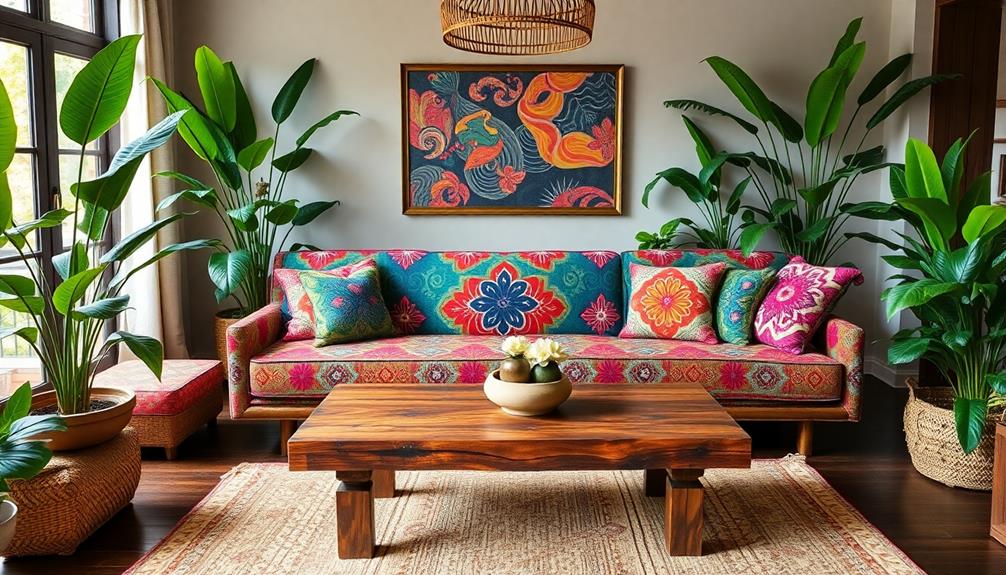
Creating a striking focal point in your interior can transform the entire atmosphere of a room. To achieve this, consider incorporating a statement piece like a vibrant Batik wall hanging or a large-scale Ikat tapestry. These elements can draw attention and set the tone for your design.
Additionally, you might incorporate traditional motifs from Indonesian wedding decor, such as intricate wooden carvings or vibrant color palettes, to enrich the overall aesthetic traditional batik patterns.
Here are some tips to help you create an enchanting focal point:
- Position focal points strategically to align with your overall design theme.
- Incorporate bold artwork or unique lighting fixtures to enhance the visual impact of Indonesian textiles.
- Limit the number of competing focal points to maintain clarity and focus in your decor.
- Choose a focal point that complements the color palette and texture of your textiles.
Embracing Personal Style

Incorporating Indonesian textiles into your interior allows you to showcase your personal style while celebrating cultural heritage. Embrace your individuality by selecting textiles that resonate with your taste—whether it's the vibrant hues of Batik or the intricate patterns of Songket.
These choices create a unique design narrative in your space, much like the modern tropical aesthetics in Bali that blend indoor and outdoor environments.
Mixing traditional hand-woven fabrics with contemporary pieces reflects your personality and honors the rich history and craftsmanship of Indonesian textiles. Consider incorporating a variety of textiles from different regions, like Bali's colorful weaves or Sumatra's gold-threaded Songket, to achieve a diverse yet cohesive look that truly showcases your style.
Trust your instincts when combining these textiles. Pair bold Batik prints with solid colors or understated patterns to add depth and personal flair to your interior design.
Stay updated on current design trends while weaving in Indonesian textiles, ensuring your decor choices remain both expressive and relevant.
As you explore your options, think like an interior designer—creating a harmonious blend that speaks to your unique aesthetic while paying homage to the cultural stories behind each textile. Your home should reflect who you are, and these textiles can help tell that story beautifully.
Practical Tips for Implementation
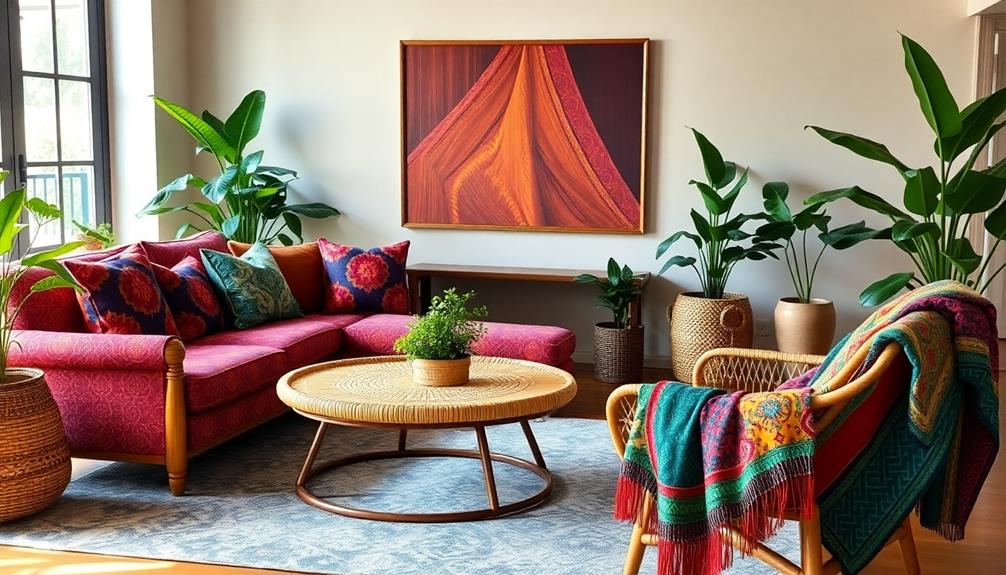
Plunge into the world of Indonesian textiles by establishing a cohesive color palette that reflects their vibrant hues. Start by selecting colors inspired by the rich patterns of batik and the earthy tones of ikat. This foundation guarantees harmony throughout your space.
Next, incorporate a variety of textiles in different forms to add depth:
- Use batik for bold cushions.
- Layer ikat throws on your sofa.
- Hang songket wall art for cultural flair.
- Mix smaller textile pieces with larger ones to balance the visual appeal.
To prevent overwhelming your space, limit your patterns to two or three types. Choose designs that share similar colors or motifs, creating a cohesive theme that resonates with Indonesian culture.
Experiment with placement by layering textiles across furniture and decor. For example, opt for songket upholstery and accent with batik pillows.
This curated approach achieves a collected look while celebrating the unique beauty of Indonesian textiles. With these tips, you'll create a vibrant, inviting space that reflects your personal style while honoring the rich heritage of Indonesia.
Frequently Asked Questions
How to Mix Patterns in Interior Design?
To mix patterns in interior design, start with a cohesive color palette. Use 2-3 types of patterns, balancing large and small ones. Layer textures and strategically place patterns for a curated, harmonious look.
How Do You Mix Textiles?
Mixing textiles can feel challenging, but you can simplify it. Start with a cohesive color palette, balance patterns, layer textures, and combine different scales to create a dynamic and inviting space that reflects your style.
How Are Textiles Used in Interior Design?
Textiles enhance your interior design by adding warmth and texture. You can use them to create layers, introduce vibrant colors, and establish a cohesive look, making your space feel inviting and personally styled.
Conclusion
By incorporating Indonesian textiles like batik into your interior design, you're not just beautifying your space; you're also honoring a tradition that dates back over 1,000 years. Did you know that batik is recognized by UNESCO as an Intangible Cultural Heritage? Embracing these rich fabrics allows you to create a unique atmosphere while celebrating their cultural significance. So, don't hesitate to mix and match—your home can reflect your personal style and tell a story all at once.
